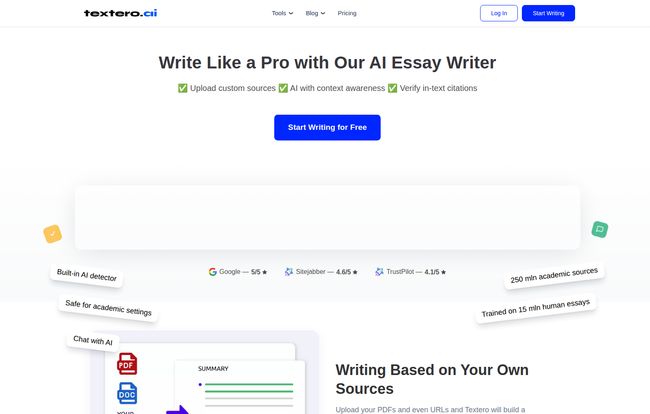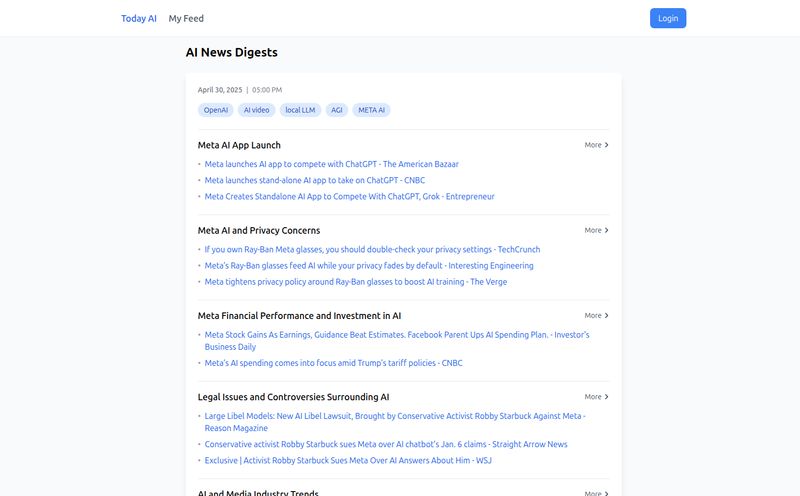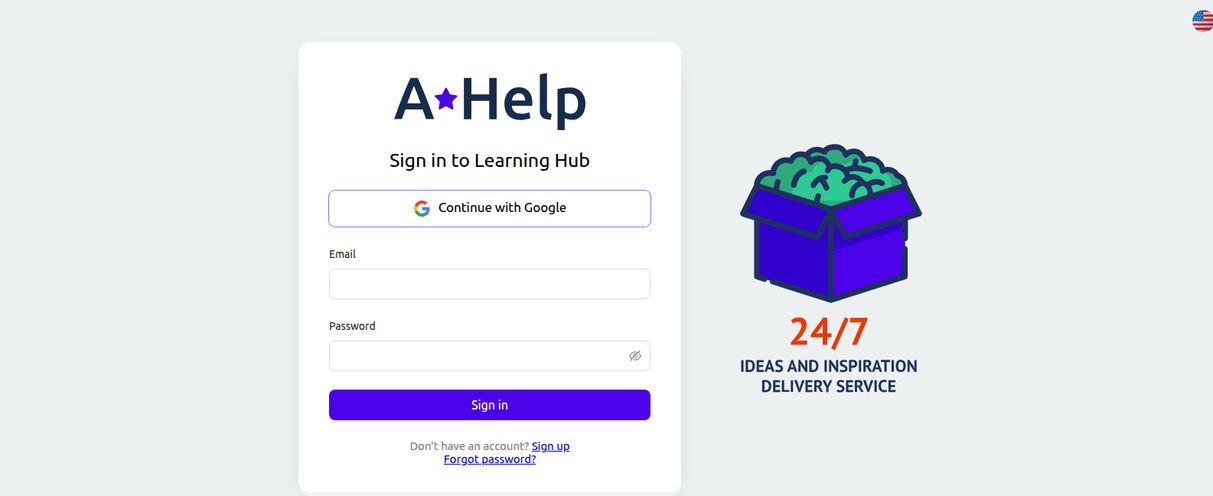We've all been there. The deadline is screaming. The cursor is blinking. A silent, mocking pulse on an empty page. That pit in your stomach when you have a 10-page paper due on a topic you're still trying to wrap your head around. For decades, the only solution was a grim cocktail of caffeine, desperation, and a prayer to the library gods.
But now, there's a new player at the table: AI. And oh boy, is it causing a stir. As someone who's spent years in the trenches of content, SEO, and traffic, I've seen dozens of AI tools pop up, each promising to revolutionize writing. Most of them are... okay. They're like a clumsy intern—enthusiastic but often needing a lot of hand-holding. But every now and then, a tool comes along that feels a little different. A little more specialized. That's the vibe I'm getting from Textero.ai.
So, I decided to take it for a spin. Is it just another ChatGPT clone, or is it genuinely a useful tool for its target audience: students and academics? Let's get into it.
So, What Exactly is Textero.ai?
First off, Textero.ai isn’t trying to be your all-in-one AI buddy that can write you a poem, a marketing email, and then a Python script. It knows its lane, and it stays there. Textero.ai is an AI writing tool built specifically for academic work. Think essays, research papers, and reports. It’s designed from the ground up to help you generate structured, well-researched, and properly cited content.
Think of it less like a ghostwriter and more like a super-powered research assistant. It's built to help with the most tedious parts of academic writing:
- Finding relevant sources
- Structuring an argument with an outline
- Summarizing dense articles
- And, of course, getting those first (and often hardest) words on the page.
It's not about cheating the system. It’s about streamlining the grunt work so you can focus on the actual thinking and analysis. Or, at least, that's the promise.

Visit Textero.ai
The Features That Actually Matter
A platform is only as good as its tools. Textero.ai has a few core features that form its backbone. Some are more impressive than others, but together they make a pretty compelling package.
The AI Essay & Paper Generator
This is the main event. You give it a topic, specify the length, the citation style (MLA or APA, thank god), and it gets to work. What I find interesting is its claim of “Context Awareness.” It's not just pulling random facts. It actively tries to build a coherent argument based on the sources it finds. This is a big step up from the early days of AI text generation which often felt like a weird, nonsensical word salad.
The Citation Game Changer
Honestly, this might be the most valuable feature for any student who’s ever lost points for a messed-up works cited page. We've all spent hours agonizing over comma placement and whether to use “Vol.” or “vol.” Textero.ai integrates verified in-text citations as it writes. This is a massive time-saver and a huge headache reducer. Of course, you should always, always double-check them. Trust, but verify, especially when your grades are on the line.
AI Research Assistant & Outline Generator
For me, this is where the real magic is. Before you even write a single sentence of the essay, you can use these tools to map out your paper. The Outline Generator helps you create a logical flow for your argument, which is half the battle. The Research Assistant helps you find credible sources to back up your points. Using this feels less like “getting an AI to write my paper” and more like having an incredibly efficient brainstorming session to overcome that initial writers block.
Textero.ai vs. The Elephant in the Room: ChatGPT
You can't talk about an AI writer without mentioning the big one. So how does Textero.ai stack up against ChatGPT? Well, it’s a bit of an apples-and-oranges situation. ChatGPT is a jack-of-all-trades. It's amazing for a lot of things. But for academic writing, it has some well-known flaws.
ChatGPT can famously “hallucinate”—a polite way of saying it makes things up. It will invent sources, misinterpret data, and its knowledge is limited to its last training update. As Textero.ai's own site points out, it's also not built for long-form, structured papers.
Textero.ai, on the other hand, is a specialist. It’s trained on academic databases and sources, so the information is supposedly more reliable and relevant. The whole platform is geared towards producing a research paper, not just a block of text. In my experience, for specific, high-stakes tasks, a specialized tool almost always outperforms a general one. You wouldn't use a Swiss Army knife for brain surgery, would you?
Let's Talk Money: The Textero.ai Pricing Plans
Alright, the all-important question: what's this going to cost? The good news is, you can kick the tires for free.
There are basically two tiers:
- The Free Plan: This gets you 550 AI words per day, which is enough to generate a short outline or a couple of paragraphs. You can write 2-page essays and get basic AI detection. It's a great way to test the platform's feel and functionality without pulling out your credit card. Think of it as a generous free sample.
- The Unlimited Plan: This is the real deal. For $8.33 per month (which is billed as a lump sum of $99.99 annually), you get everything. Unlimited AI words, up to 25-page essays, unlimited AI detection, and access to the “Deep Research” feature.
Is the paid plan worth it? If you're a student with a heavy course load, I'd say yes. Eight bucks a month is less than two fancy coffees. If it saves you even a few hours of stressful, late-night writing per month, it's probably paid for itself in saved sanity.
The Good, The Bad, and The Realistic
No tool is perfect. Let's break down my honest take after playing around with it.
What I Really Like
The biggest pro is its ability to smash through writer's block. It's a fantastic starting point. Getting that initial 500-word draft done, complete with a structure and some sources, can be incredibly motivating. The focus on academic integrity is also a huge plus. The built-in plagiarism and AI checkers show that they understand the tightrope students are walking. They're positioning it as an assistant, not a cheat code.
Where You Need to Be Careful
And now for the reality check. You cannot just copy, paste, and submit the work Textero.ai generates. You just can't. The content it produces is a first draft. A pretty good one, sometimes! But it will always lack your unique voice, your critical insights, and your personal analytical style. I like to think of it this way: the AI gives you a lump of clay; you still have to be the sculptor. You need to edit, rewrite, and inject your own brainpower into it.
There's also the ethical debate. Every university is creating its own policies on AI use. Some professors are embracing it as a tool, others are banning it outright. The smart move? Use Textero.ai for research, outlining, and drafting, but make the final product entirely your own work and thinking. Be transparent if you're ever unsure about a professor's policy.
So, Who is Textero.ai Actually For?
This tool shines for a few specific groups. It's perfect for high school and undergraduate students who are still learning how to structure a strong academic argument. It's a huge help for ESL students who might have great ideas but struggle with academic phrasing in English. It's also useful for researchers who need to quickly get a summary of a topic or find a base of literature to start from.
It's probably not for a PhD student writing their dissertation or a professional academic publishing in a top-tier journal. At that level, the nuance and originality required are simply beyond what any AI can currently produce. But for the vast majority of student work, it's a remarkably capable assistant.
Frequently Asked Questions
- Is Textero.ai really free?
- Yes, there is a free plan! It has limits, like 550 AI words per day and shorter essays, but it's completely functional and a great way to try it out.
- Can my school or professor detect Textero.ai?
- This is the million-dollar question in education right now. Textero.ai includes its own AI detector. However, no AI detector is 100% accurate. The best way to avoid any issues is to not submit raw AI output. Use it as a tool to help you write, but ensure the final submission is thoroughly edited and reflects your own understanding and voice.
- Is the content from Textero.ai plagiarism-free?
- The platform has a built-in plagiarism checker and aims to produce unique content with proper citations. In my tests, it does a good job. However, it is always the student's final responsibility to run their paper through a tool like Turnitin and ensure all sources are correctly attributed.
- Is it better than just using ChatGPT?
- For academic essay writing, I believe so. Its specialization in academic sources, built-in citation tools, and paper-structuring features give it a clear edge over a general-purpose AI for this specific task.
- How does the AI Research Assistant work?
- You provide your topic, and the assistant scans academic databases and credible online sources to find relevant articles, studies, and information. It then presents these to you, often with summaries, so you can quickly decide which ones are most useful for your paper.
Final Thoughts: A Tool, Not a Magic Wand
After spending some quality time with Textero.ai, I'm genuinely impressed. It’s one of the better, more thoughtfully designed AI writing tools I've seen. It understands its audience and provides features that solve real, frustrating problems for students.
But it's crucial to maintain the right perspective. Textero.ai is a powerful tool, but it's just that—a tool. It's a calculator for writers, not a replacement for a mathematician. It can handle the computation and the heavy lifting, but the critical thinking, the analysis, and the spark of insight still have to come from you.
If you’re a student staring down a semester of papers, I’d say give the free plan a spin. It might just be the co-pilot you need to navigate the stormy seas of academic writing.
Reference and Sources
- Textero.ai Official Website
- Textero.ai Pricing Page
- Stanford University's Guidance on Generative AI for Instructors - A good example of how universities are thinking about these tools.



